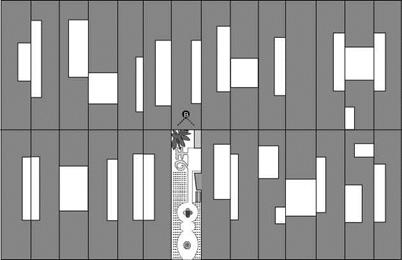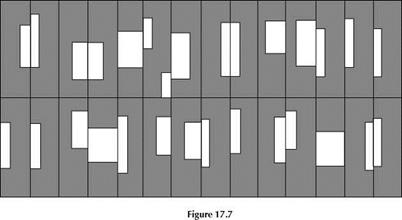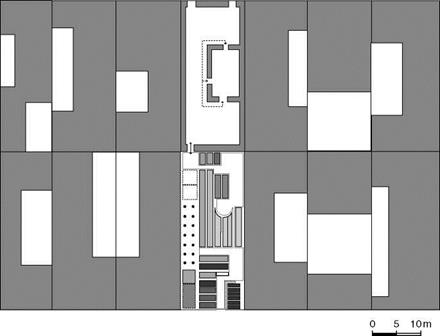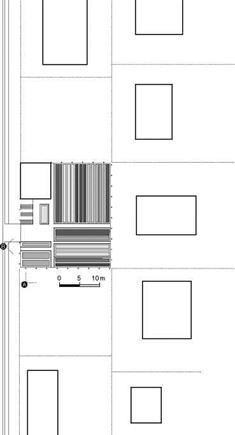In a few words we can tell you how to build an organoponico.
Divide a site up into alternate strips, 65 cm wide for paths, 120 cm wide for raised beds. Excavate the beds to a depth of 30 cm below ground, fill with stones for drainage and build retaining walls to a height of 20 cm above ground. Fill beds with soil and repeat until the site is full.
On the face of it, one organoponicos is much like another. But when one looks, it can be seen that this is not so. The particularities of each site interfere with and enrich the apparent monotony by distorting and varying it.
The urban agriculture atlas which follows, presents surveys of ten sites measured by the author during February 2002. The text accompanying the survey drawings describe conditions as found, and characteristics which could inform future design strategies. The site surveys are followed by a record of the materials used to construct planting beds for
organoponicos. In the ten sites surveyed, a mix of twenty-four materials was found, defining the edges of planted beds. In all cases these were recycled materials, some placed loosely for easy reassembling, some placed permanently. This variety of materials and the changing crop patterns over time contribute to the visual dynamics of urban agriculture and its role as a register of seasonal change.
The edges of urban agriculture sites form boundaries between the public realm of the street and the private realm of market gardens. They also offer the potential to become occupied. Security is an important issue for cultivators and a fence of some sort always surrounds urban agriculture sites in Cuba. Although these fences provide a physical barrier along boundaries, they do not prevent passers-by from looking at and sensing the urban agriculture sites. Different sites and different boundaries presented different characteristics, often determined by the ad hoc appropriation of edges for different uses, for example, the use of a fence for drying clothes. Observations in Cuba show how boundaries can offer new places for occupation and new experiences within the city.
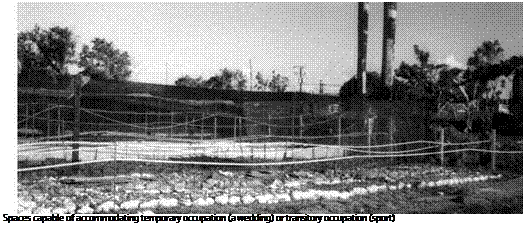
A path or road often bound one or more sides of an urban agriculture site. Networks for circulation and distribution are established, in some cases a very particular quality is generated by the simplest of elements or activities. A wall can mark a route and boundary, while its shadow creates a threedimensional comfort zone, a space providing thermal delight, encouraging a different pace and making a space to talk while viewing an ever changing landscape.
By looking out over productive urban landscapes from a window or terrace, the observer gains ownership of their territory; it is claimed by seeing. Environments become comprehensible, an urban nature is defined, personal space is expanded, from your window, and from your neighbour’s window as well!
|
E 0 5 10m |
|
|
HUERTO COMUNITARIO SAN MIGUEL, BELASCORIN Y GERVASIO. CHARACTERISTICS CENTRO HABANA


![]()
A community garden, established by a group of local women. This is one of the few examples of a permaculture garden in Cuba. The geometry is non-linear, leading occupants from the entrance towards seating spaces.
|
|
|
Figure 17.9 |
HUERTOS INTENSIVO HABANA, MERCED Y PAULA. HABANA VIEJA
![]()

 |
This site, in the historic quarter of Havana is managed by Alberto de la Paz. It provides food and functions as an educational facility for local school children, who visit and work on the crops. A tree shades an outdoor meeting space.
|
Figure 17.11 |
ORGANOPONICO PUEBLO GRIFO VIEJO CHARACTERISTICS CIENFUEGOS
 A site for home working, this small organoponico is located within the curtilage of a suburban plot. It is small enough for one person to be able to cultivate it. At this scale it does not challenge, or react to the characteristic conditions of sprawl, found in adjoining plots.
A site for home working, this small organoponico is located within the curtilage of a suburban plot. It is small enough for one person to be able to cultivate it. At this scale it does not challenge, or react to the characteristic conditions of sprawl, found in adjoining plots.

CROPS MATERIALS
 recycled precast concrete beams, 40 cm by 40 cm by 5m long, earth
recycled precast concrete beams, 40 cm by 40 cm by 5m long, earth
Figure 17.12
|
|

